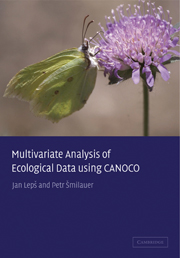Book contents
- Frontmatter
- Contents
- Preface
- 1 Introduction and data manipulation
- 2 Experimental design
- 3 Basics of gradient analysis
- 4 Using the Canoco for Windows 4.5 package
- 5 Constrained ordination and permutation tests
- 6 Similarity measures
- 7 Classification methods
- 8 Regression methods
- 9 Advanced use of ordination
- 10 Visualizing multivariate data
- 11 Case study 1: Variation in forest bird assemblages
- 12 Case study 2: Search for community composition patterns and their environmental correlates: vegetation of spring meadows
- 13 Case study 3: Separating the effects of explanatory variables
- 14 Case study 4: Evaluation of experiments in randomized complete blocks
- 15 Case study 5: Analysis of repeated observations of species composition from a factorial experiment
- 16 Case study 6: Hierarchical analysis of crayfish community variation
- 17 Case study 7: Differentiating two species and their hybrids with discriminant analysis
- Appendix A Sample datasets and projects
- Appendix B Vocabulary
- Appendix C Overview of available software
- References
- Index
2 - Experimental design
Published online by Cambridge University Press: 09 February 2010
- Frontmatter
- Contents
- Preface
- 1 Introduction and data manipulation
- 2 Experimental design
- 3 Basics of gradient analysis
- 4 Using the Canoco for Windows 4.5 package
- 5 Constrained ordination and permutation tests
- 6 Similarity measures
- 7 Classification methods
- 8 Regression methods
- 9 Advanced use of ordination
- 10 Visualizing multivariate data
- 11 Case study 1: Variation in forest bird assemblages
- 12 Case study 2: Search for community composition patterns and their environmental correlates: vegetation of spring meadows
- 13 Case study 3: Separating the effects of explanatory variables
- 14 Case study 4: Evaluation of experiments in randomized complete blocks
- 15 Case study 5: Analysis of repeated observations of species composition from a factorial experiment
- 16 Case study 6: Hierarchical analysis of crayfish community variation
- 17 Case study 7: Differentiating two species and their hybrids with discriminant analysis
- Appendix A Sample datasets and projects
- Appendix B Vocabulary
- Appendix C Overview of available software
- References
- Index
Summary
Multivariate methods are no longer restricted to the exploration of data and to the generation of new hypotheses. In particular, constrained ordination is a powerful tool for analysing data from manipulative experiments. In this chapter, we review the basic types of experimental design, with an emphasis on manipulative field experiments. Generally, we expect that the aim of the experiment is to compare the response of studied objects (e.g. an ecological community) to several treatments (treatment levels). Note that one of the treatment levels is usually a control treatment (although in real ecological studies, it might be difficult to decide what is the control; for example, when we compare several types of grassland management, which of the management types is the control one?). Detailed treatment of the topics handled in this chapter can be found for example in Underwood (1997).
If the response is univariate (e.g. number of species, total biomass), then the most common analytical tools are ANOVA, general linear models (which include both ANOVA, linear regression and their combinations), or generalized linear models. Generalized linear models are an extension of general linear models for the cases where the distribution of the response variable cannot be approximated by the normal distribution.
Completely randomized design
The simplest design is the completely randomized one (Figure 2–1). We first select the plots, and then randomly assign treatment levels to individual plots. This design is correct, but not always the best, as it does not control for environmental heterogeneity. This heterogeneity is always present as an unexplained variability. If the heterogeneity is large, use of this design might decrease the power of the tests.
- Type
- Chapter
- Information
- Multivariate Analysis of Ecological Data using CANOCO , pp. 16 - 24Publisher: Cambridge University PressPrint publication year: 2003



